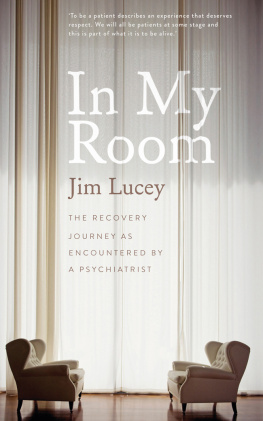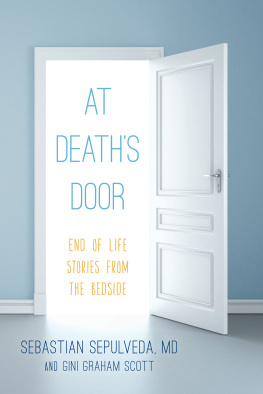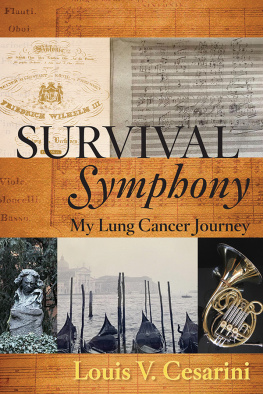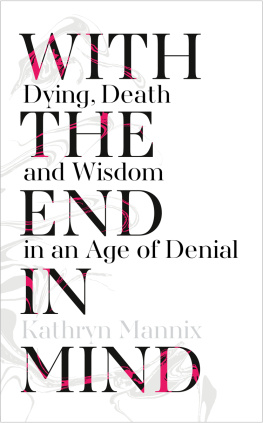Pagebreaks of the print version
It is said that in Damascus,
even if a Jasmine falls to the ground,
it doesnt die.
T HE L ONG T ALE OF T EARS AND S MILES
T HE L ONG T ALE OF T EARS AND S MILES
An Oncologists Journey
Rana Bitar, M.D.


Published by Global Collective Publishers
2628 West Chester Pike, Suite 281
Broomall, Pennsylvania 19008, USA
www.globalcollectivepublishers.com
Copyright Rana Bitar 2021
Paperback ISBN: 978-1-7344019-6-7
Hardback ISBN: 978-1-954021-22-8
eBook ISBN: 978-1-7344019-7-4
Rana Bitar asserts the moral right to be identified as the author of this work. All rights reserved. No part of this publication may be reproduced, stored in a retrieval system, or transmitted, in any form or by any means, electronic, mechanical, photocopying, recording or otherwise, without the prior permission of Global Collective Publishers.
Cover Photo Credit: Ado Milan
For the tune that hums
unceasingly in the labyrinth of my soul,
I pick up my pen and write again .
C ONFESSION
My daughter gave this book its title. She was six years old when she stapled a bunch of white loose-leaf papers together to make her book. She called it, A Long Tale of Smiles . In the book, she drew different types of smiles: square, round, heart-shaped, etc. When I saw her drawings, I thought of all the different shapes of the many smiles and tears that I have seen along my journey. I thought that the title of my daughters book would be a perfect one for the tale I am about to tell.
P ROLOGUE
Break a vase, and the love that reassembles the fragments is stronger than that love which took its symmetry for granted when it was whole .
Derek Walcott, The Nobel Lecture , 1992
When I was six, my dad went to East Germany on one of his many international business trips as the head of the Central Bank of Syria. In addition to the commemorative silver coins that my father would be presented with on such trips, the German Diplomatic Assembly sent him home with a special gift. The gift was a tea set that I fell in love with at first sight and immediately claimed ownership ofat least in my mind. Six teacups and saucers, one teapot, one creamer, and one sugar bowl were each tucked into their own specially carved-out place within an elegant travel case. Red satin lined the bottom of the case and engulfed each piece as tenderly as a mothers palm protects her newborns eyes from a bright light. Yet the pieces slid in and out of their little enclosures with ease. The upper part of the case was lined with cushioned layers of thick red velvet. As the top part closed on the lower, the lush velvet covered the pieces, which were cradled in satin. The case had two golden metal snap locks on each side that clicked to open and close like the heels of two soldiers, opening the castles gate to greet the princess that I was.
As was often the fate of precious things in our house, my mom tucked the suitcase away in a cabinet for safekeeping. The red case was sheltered in next to the family heirlooms: vintage silverware and crystal vases.
During the adults mid-day siesta, I would sneak into the dining room, quietly kneel on the floor, and carefully open the doors to the cabinet, lest the squeak of the hinges betray me. I would slide out the case, and my fingers would maneuver around the snapping locks and tease them open slowlyto muffle their click. The set was of bone china, creamy white, with hand-painted orange vines. The vines twisted around with whimsical, undulating curves that were budded with delicate flowers. Each cups handle curved in an artful pause like a ballerinas arm, leaving room for the tips of two fingers. The edges of the teacups curled in and out in a wavy dance, and a band of gold encased the lips. The lids that topped the pot and the sugar bowl had the shape of a canopy, with a single rose on top to serve as a handle.
I would gently remove each individual piece of the set, with infinite patience (for a child). Quietly, I would first line them up on the floor, then I would close the suitcase and use it as a table to carefully arrange the cups and the pot atop. The set was smaller than a traditional tea set, which made it more appealing to my little girls fantastical world and rendered it more convincing to my playdate company: my imaginary friends.
My imaginary friends then would come to visit. First, the fairy, whose wings fluttered as I whispered my impossible wishes in her ears. Next, the queen; from her stern features, I garnered my certitude. And last was the knight in his metal armor; he combated my ghosts with a victorious grin that I could draw even though I never saw his face. My friends and I would gather around the set to have the most delicious cup of tea with extra sugar, and would indulge in warm heartfelt conversations.
I thought my mother had no idea that those parties took place during siesta, but when she and my dad fled the civil war in Syria and came to the United States many years later, I discovered that she did. In one of the two large suitcases they brought with them, the tea set of my childhood was nestled in its red case, untouched, just like I left it years and years before, eagerly waiting for me to unhook the locks. My mom handed me the case, and I accepted. No words were spoken; there were no words that could have carried the weight of that moment.
When my husband and I bought our first home in the United States, the first item to be put on display was the tea set. It sat on the top shelf of the glass cabinet in my dining room, and I retired the suitcase with its satin shimmer to the basement closet. Like smiles, each piece of the set greeted me every day from behind the glass.
One Saturday morning, I was awakened by the sound of glass shattering. I ran downstairs in dread, only to find the tea set in tiny pieces all over the dining room floor. It must have been that the set moved slowly along the shelf as we walked back and forth over the years, shaking the wooden floor. When a few pieces reached the edge of the glass shelf, it tilted slightly under the weight, and the set slid off, one piece after the other. The tea set, within which my childhood memories were encased, had scattered on the floor like teardrops.
The fragility of our keepings! I froze in disbelief at the sight. Although my heart was stunned, my mind was racing and thinking that it was impossible to put these tiny pieces together again and resurrect the set. But I was also thinking that it was impossible not to. It was impossible to let go of it and dispose of remembrance just like that.
So, I got to work. I collected the pieces, from the largest to the tiniest, on three large trays. And over the following few weekends, with the help of crazy glue and my vivid memory of the details of the pieces, I put the set back together.
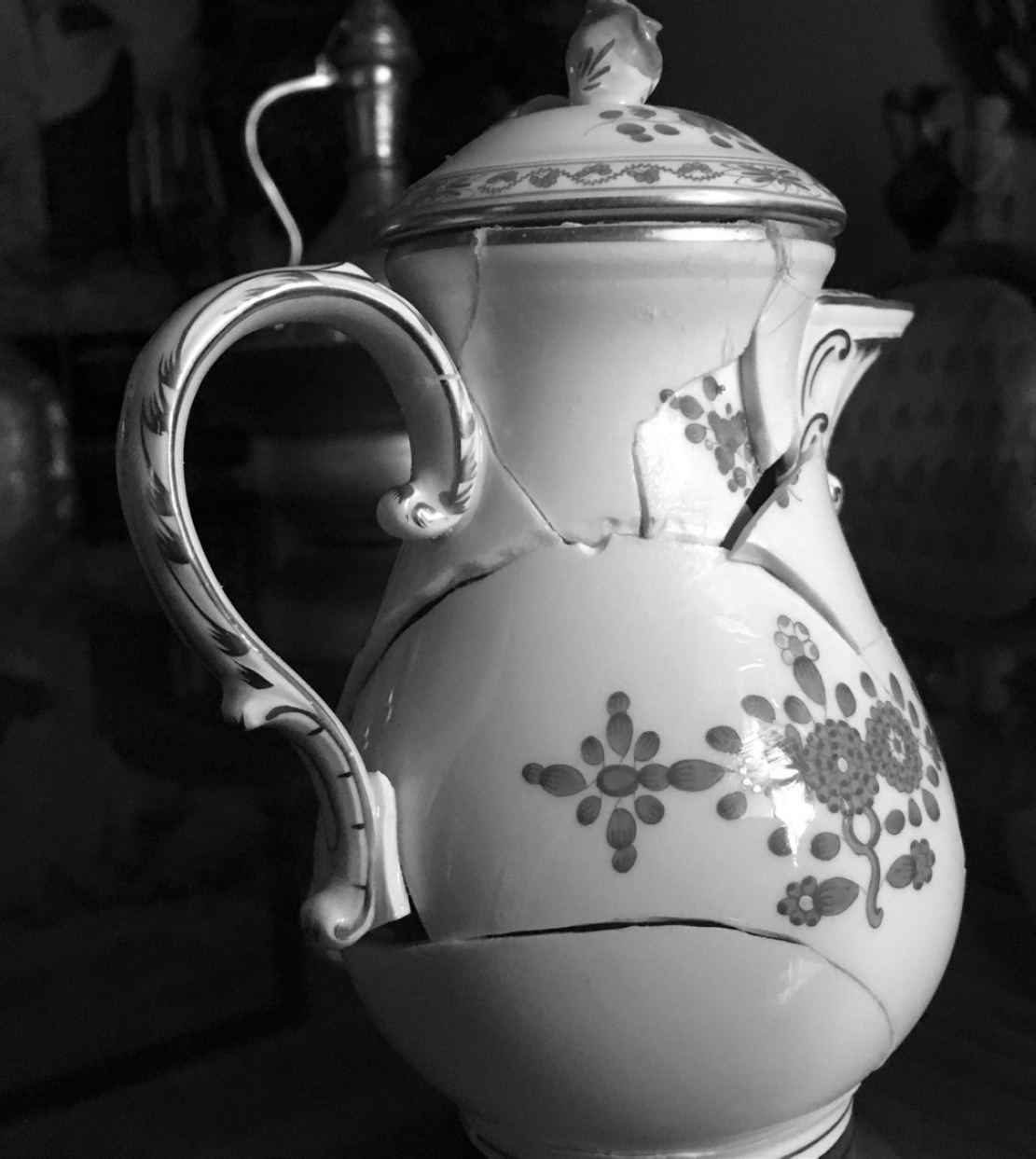
The teapot after repair.
I cannot tolerate losing things I cherish to a break or a snap or a stretch or a tear. If it can be fixed, I am intent on fixing it and resurrecting it to its original status as accurately as possible. And when it is not possible to put it together as perfect as it was before, I still marvel at the spirit that comes alive and vivid as I try to glue the shattered pieces together and as the new creation takes on a new journey. At times, when things cannot be glued or stitched or melded together, I keep the separate pieces on standby, ready to use in future repair projects. A small part of something gone adds a new character to something new.


